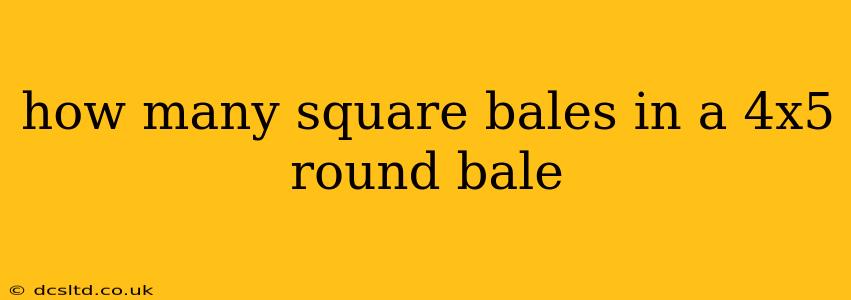How Many Square Bales in a 4x5 Round Bale? A Comprehensive Guide
Determining the equivalent number of square bales in a round bale isn't an exact science, as it depends on several factors including the density of the round bale, the size and density of the square bales, and the type of hay or forage. However, we can provide a reasonable estimate and explore the variables involved.
The question "how many square bales in a 4x5 round bale?" often arises when farmers need to plan storage, transport, or feeding strategies. Let's break down this calculation and address some related concerns.
Understanding Bale Dimensions and Density
A "4x5 round bale" typically refers to a round bale approximately 4 feet wide and 5 feet long. However, these dimensions can vary slightly depending on the baler and the conditions under which the bale was made. Similarly, square bales come in various sizes, the most common being 14"x18"x36" and 16"x18"x48". The density of both round and square bales also influences the overall weight and volume. Densely packed bales will contain more hay in the same volume.
Estimating Equivalent Square Bales
A generally accepted rule of thumb is that one 4x5 round bale is approximately equivalent to between 8 and 12 standard-sized square bales (14"x18"x36" or similar). This range accounts for the variations in bale density and size. A looser, less dense round bale would equate to fewer square bales, while a tightly packed one would equate to more.
Factors Affecting the Equivalency:
- Hay Type: The type of hay significantly impacts density. Alfalfa tends to be denser than grass hay, meaning a round bale of alfalfa will have a higher equivalent in square bales.
- Bale Moisture: Higher moisture content results in a heavier, denser bale, potentially increasing the equivalent square bale count.
- Baling Equipment: Different balers produce bales with varying densities.
- Square Bale Dimensions: The exact dimensions of your square bales will directly influence the conversion. Larger square bales will naturally reduce the total number needed to equal a round bale.
How to Get a More Accurate Estimate:
To get a closer estimate, consider the following:
-
Weigh the round bale: The weight of the round bale provides the most reliable measure. Divide the round bale's weight by the average weight of a standard-sized square bale of the same hay type to get a more accurate comparison.
-
Measure the volume: Calculating the volume of both the round and square bales (using appropriate formulas) and comparing the volumes can provide another method for estimation. However, this approach still relies on the assumption of similar densities.
Other Frequently Asked Questions:
How much hay is in a 4x5 round bale? The amount of hay varies considerably depending on the density, but it's often in the range of 800-1200 pounds.
What's the difference between a 4x4 and a 4x5 round bale? The main difference is length. A 4x5 round bale is longer (5 feet) than a 4x4 round bale (4 feet), resulting in a larger volume and therefore more hay.
What is the best way to store round bales? Round bales should be stored in a dry, well-ventilated area, ideally off the ground to prevent moisture damage.
By considering these factors and employing the strategies outlined, farmers can arrive at a more accurate estimation of the equivalent number of square bales in their 4x5 round bales, ensuring more effective planning and management of their hay resources.
